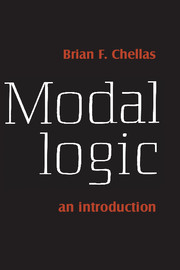9 - Determination and decidability for classical systems
Published online by Cambridge University Press: 05 June 2012
Summary
In this chapter we connect classical modal logics and classes of minimal models by way of determination theorems. Our method is much the same as in chapter 5 for normal systems and standard models. In section 9.1 we treat questions of soundness and prove the distinctness of the eight classical systems on the diagram in figure 8.1 having M, C, and N as theorems. Section 9.2 contains the definition of canonical minimal models and the fundamental theorems for completeness. We do not single out any particular canonical minimal model as ‘proper’, as we did in the case of normal systems. But we indicate a uniform way of describing canonical minimal models – a way that highlights two very useful such models, which we call the smallest and the largest, for any classical logic.
In section 9.3 there are determination theorems for the systems in figure 8.1. The idea of supplementation plays an important part in obtaining completeness results for the monotonic systems, and we use augmentation to reach, again, the conclusion that normal systems are complete with respect to the class of standard models. Then in section 9.4 we treat in an abridged fashion questions of completeness for classical systems having as theorems familiar schemas such as D, T, B, 4, and 5. Finally, in section 9.5 we prove the decidability of the systems E, M, R, and, once again, K.
- Type
- Chapter
- Information
- Modal LogicAn Introduction, pp. 248 - 267Publisher: Cambridge University PressPrint publication year: 1980

